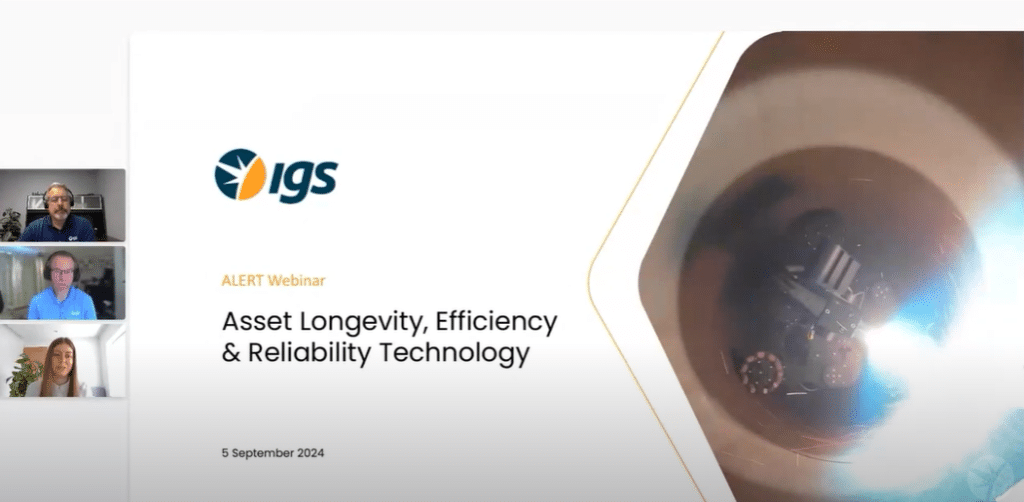Asset Longevity, Efficiency & Reliability Technology Webinar Q&A

Missed our webinar “Asset Longevity, Efficiency & Reliability Technology”? Read all of the Q&As and watch the full webinar now.
Cladding and Piping
Q: What is the minimum size of piping in which cladding can be done by IGS without flanges?
A: The IGS Metalspray rover can perform cladding on piping with an internal diameter of 24″ to 42″. Here is a video: https://www.youtube.com/watch?v=lS6-ktQfNc4
Cleaning Convection Sections
Q: What is an efficient method to clean convection sections online?
A: An online convection section cleaning process is available. A video demonstration showcasing this process can be found, here: https://youtu.be/ASMSwML2c-4?si=ev5AbM_n9sA7_c8K
Refractory and Metallurgy
Q: What type of pumpable refractory is used for internal walls?
A: The type of refractory used depends on the specific application. There are about half a dozen options available based on the specific needs.
HVTS and HVOF Processes
Q: What is the difference between HVTS and HVOF?
A: HVTS (High Velocity Thermal Spray) is a thermal spray process that utilizes a high velocity gas flow. HVOF (High Velocity Oxy-Fuel) is an HVTS process that uses powder instead of wire feedstock and a supersonic combustion flame. IGS HVTS is designed to deliver cladding systems with low impurities, a high density and strong adhesion utilizing either modified powder or wire feedstock materials.
Q: Is there a damage mechanism that HVTS would not be able to handle?
A: HVTS is designed to be a barrier to address metal wastage from erosion and corrosion mechanisms. It is not suitable for mechanical damage, stress or failure mechanisms. As a barrier system it can protect against corrosion driven damage mechanisms, slow down erosion, but not mechanical structural integrity issues.
Q: Has HVTS been used to repair metal dusting at WHB entrance tubes at the tube sheet?
A: Yes, the HVTS process has been successfully used to address metal dusting at Waste Heat Boiler (WHB) entrance tubes at the tube sheet. There is significant experience in reducing the onset and speed of degradation in these cases.
Q: How thick is the metal cladding in HVTS?
A: The nominal thickness of metal cladding is typically 500 microns.
Inspection and Quality Control
Q: What type of inspection is used to check the integrity/quality of HVTS?
A: Various inspection methods are used, including industry standard tests for surface preparation and some in-situ tests by IGS. Other tests may require laboratory analysis, which can be carried out at IGS’s technical centre in the US.
Changing or Replacing HVTS
Q: If HVTS with CRA is applied in a column and the client later requires changing the alloy, is it possible without complete replacement?
A: If a change in alloy is required, the existing HVTS system would need to be removed and replaced. However, if repairs are needed only in specific zones, quick repairs and replacement is possible.
Longevity of HVTS
Q: How long can HVTS remain in place before replacement might be required?
A: The duration varies depending on the environment:
– In mechanically abrasive environments, there will be a defined end of life.
– In purely corrosive environments, the alloy system can potentially last for the lifetime of the equipment.
Refractory Coatings
Q: What types of materials are used for refractory coatings on brick linings, castable linings, and ceramic fiber modules?
A: Different formulas are available for coating various surfaces such as brick linings, castable linings, and ceramic fiber modules. The choice of coating depends on the desired emissivity and the specific requirements inside the heater. A technical evaluation is carried out before each project.
HVTS vs. TSA Coating
Q: Is HVTS better than TSA Coating for corrosion mitigation?
A: HVTS and TSA (Thermal Spray Aluminium) are designed for different operating conditions:
– TSA is proven to be effective in conditions such as saltwater, but is not suitable for internal protection in harsh, high-temperature environments.
– HVTS is more versatile for challenging internal environments.
HVTS on Titanium
Q: Can HVTS be applied to titanium material?
A: Yes, HVTS can be applied to titanium materials. However, the specific requirements depend on the protection needs and substrate preparation.
Corrosion Under HVTS Coating
Q: Have clients ever experienced corrosion of the substrate metal below the HVTS coating?
A: Corrosion of the substrate metal below the HVTS coating can occur if there’s a breach in the integrity of the cladding system. Measures are taken to minimize this risk, but local spalling can happen if a pathway exists. Whilst it is a risk, it is uncommon.
HVTS Application Limitations
Q: What are the limitations of HVTS and can it be applied in any configuration or orientation?
A: The main limitations of HVTS application are physical:
– Access to the surface is required for preparation and application e.g. baffles and deflectors may need to be removed to provide access.
– Size and access requirements can be constraints.
From a chemical and temperature perspective, solutions can usually be developed to address specific needs.
The quality of HVTS application primarily depends on the experience of the applicator. That’s why IGS develops and applies HVTS using well-trained and experienced teams of IGS employees, stationed worldwide.
